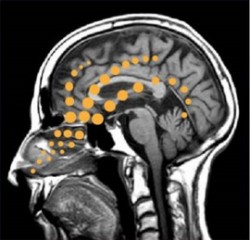Impel’s POD device helps drugs jump the blood-brain barrier
 It sounds like science fiction: a device that delivers pharmaceutical drugs directly to the brain using something called “nose-to-brain” transport. But this is no sci-fi tale. The Pressurized Olfactory Delivery (POD) device, developed by John Hoekman, UW PhD in pharmaceutics and chief scientific officer of Impel NeuroPharma, has the potential to solve one of the biggest problems facing the neurological drug industry today: getting drug molecules beyond the blood-brain barrier and into the central nervous system.
It sounds like science fiction: a device that delivers pharmaceutical drugs directly to the brain using something called “nose-to-brain” transport. But this is no sci-fi tale. The Pressurized Olfactory Delivery (POD) device, developed by John Hoekman, UW PhD in pharmaceutics and chief scientific officer of Impel NeuroPharma, has the potential to solve one of the biggest problems facing the neurological drug industry today: getting drug molecules beyond the blood-brain barrier and into the central nervous system.
While conducting research in neurological drug delivery at the UW, Hoekman saw how the nose-to-brain pathway could improve drug delivery save for one small issue: there were no devices capable of reaching the upper nasal cavity to utilize this pathway. He began working with Dr. Rodney Ho in the UW Department of Pharmaceutics to develop a commercial device that would be cost-effective, disposable and user-friendly. “We’ve developed the POD device to be an elegant mechanical solution in a space plagued by biological problems,” says Michael Hite (MBA 2009), CEO of Impel. “Rather than manipulate drug properties chemically to improve absorption by the brain, the POD device simply delivers them to a region in the body where they will naturally be readily absorbed into the brain.”
For many drugs, this ability to move drugs beyond the blood-brain barrier means lowering the dosage, reducing organ exposure and lessening side effects. It can also have significant impact for biologic-based drugs such as peptides and proteins—drugs that hold tremendous promise for treating diseases such as Alzheimer’s and Parkinson’s but that can’t make it to clinical trials due to the lack of a viable delivery mechanism.
Hoekman and Hite took Impel to the 2008 UW Business Plan Competition, where they won the $25,000 Grand Prize as well as a Best Idea Prize for Innovation. They then worked with the UW Center for Commercialization to license their technology, produce a prototype device and select candidates for proof-of-concept trials. “The BPC prize raised our profile and provided credibility with angel investors,” says Hite. “One of the lessons we learned was how to convey not only the technological break-through of the POD device, but also the advantages of our business model to angel investors. As a pharmaceutical technology provider, Impel adds value to products in the $60 billion-plus central nervous system therapeutics market without having to launch its own drug products.”
As one might expect for a life sciences start-up, the last 18 months have been make or break time. In early 2010, the company raised its first outside seed capital from some of the Northwest’s most well-known life science angel investors, including members of the Alliance of Angels, WINGS and Bay Area angel groups. With over $1.1 million in private and public funding raised, the company has been able to conduct proof-of-concept work and scale up the POD device in anticipation of human trials, including a successful demonstration of the device using neuro-oncology tracers in PET imaging studies. Impel’s device will soon see its first in-human trial for the targeted delivery of analgesics to the brain as part of a study being conducted later this year by UW SOM researchers, funded in part by a life science discovery fund commercialization grant. This analgesic program has broad treatment applications, including post-operative and cancer pain.
Hite says that Impel has thrived because he and Hoekman have quickly addressed the concerns of their critics and improved the design of their device.
What advice does he have for other first-time entrepreneurs? “Don’t just begrudgingly accept help, but go out and seek advice, assistance and opinions from successful entrepreneurs. CIE has built a great network of advisors who can provide that invaluable experience.”
